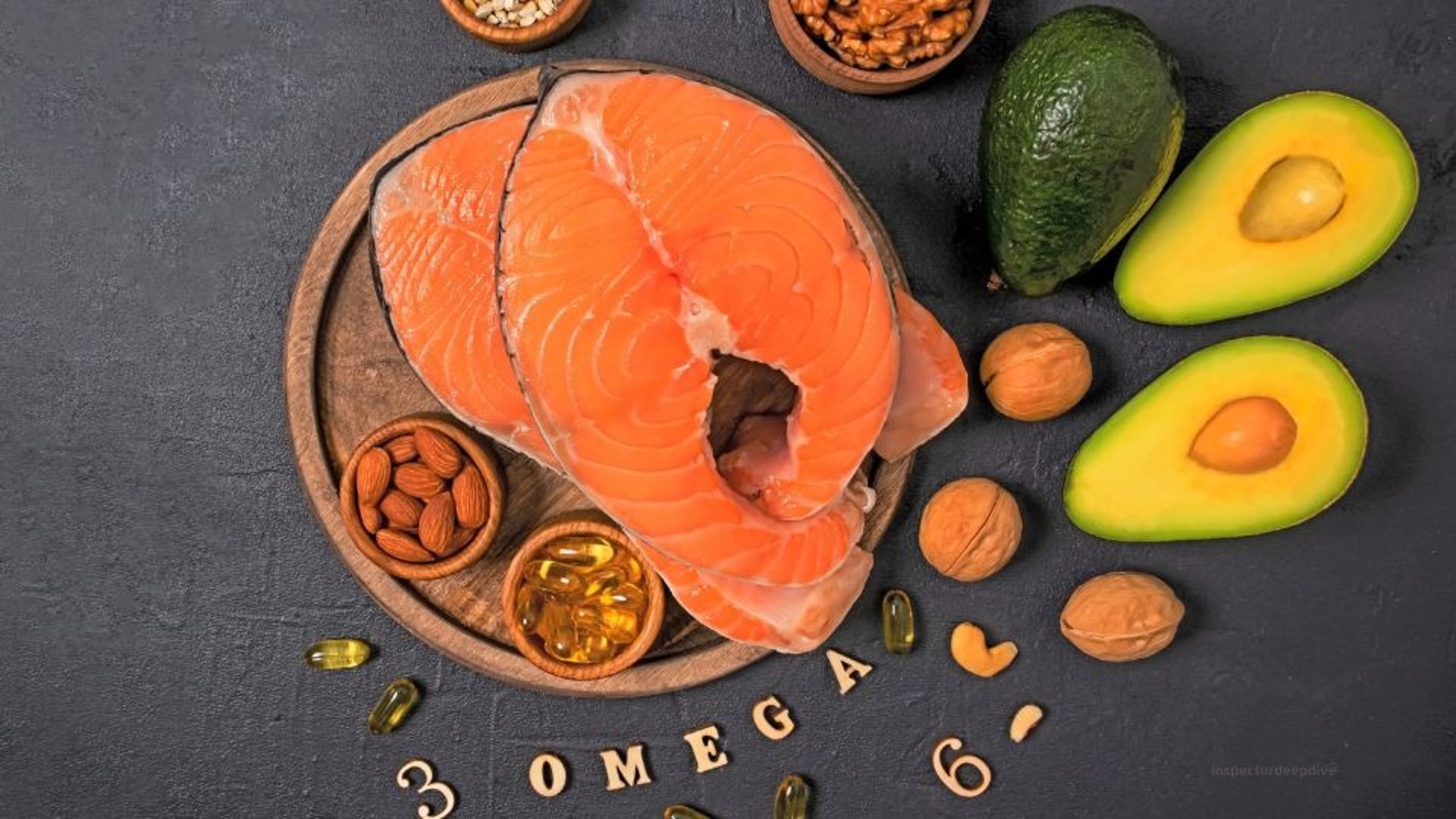Omega-3 Fatty Acids: The Super Fats!

Omega-3 Superfoods The Super Fats!
What are the three super fats?
EPA (eicosapentaenoic acid): Helps calm inflammation (the body’s “alarm”), supports heart health, and can help mood. Mostly found in fish and algae.
DHA (docosahexaenoic acid): A building block for the brain, eyes (retina), and skin. Very important for baby brain growth and keeping your brain sharp. Found in fish, seafood, and algal oil.
ALA (alpha‑linolenic acid): A plant omega‑3 found in seeds, nuts, and some oils. Your body can turn ALA into EPA and DHA, but only a little bit.
How omega-3s work (simple)
When you eat omega‑3s, they become part of your cells especially in the brain, eyes, and heart. They:
Keep cell parts flexible so cells talk to each other properly.
Help make signaling molecules (like eicosanoids) that control inflammation, blood clotting, and immune responses.
EPA mostly helps lower inflammation.
DHA helps build and protect brain and eye cells.
Fish (EPA & DHA) approx per 100 g
Mackerel (cooked): 4,500–5,000 mg
Salmon (wild): 2,000–2,500 mg
Herring: 2,000–2,500 mg
Sardines (canned): 1,480 mg
Anchovies: 1,000–1,500 mg
Caviar (fish eggs): 1,000–1,500 mg
Oysters (cooked): 700–900 mg
Rainbow trout: 700–800 mg
Pollock (Alaskan): 600–700 mg
Tuna (bluefin/albacore): 500–700 mg
Sea bass / Halibut: 300–400 mg
Cod (baked): 250–300 mg
Clams: 200–300 mg
Shrimp: 150–250 mg
Meats & Eggs approximate omega‑3 (mostly EPA+DHA) per 100 g unless noted
(Values vary widely by feed, breed, and cut grass‑fed animals usually have more omega‑3s than grain‑fed.)
Grass‑fed beef: 80–200 mg per 100 g (varies by cut/fat content)
Grain‑fed beef: 20–50 mg per 100 g
Lamb (grass‑fed): 100–200 mg per 100 g
Pork: 20–60 mg per 100 g (higher if pasture‑raised)
Chicken breast (skinless, white meat): 20–30 mg per 100 g
Chicken dark meat (thigh): 40–70 mg per 100 g
Turkey (white): 20–40 mg per 100 g; dark meat slightly more
Duck (higher fat): 80–150 mg per 100 g
Organ meats (liver): ~50–200 mg per 100 g (varies)
Regular egg (one large): 30–70 mg total omega‑3 (often more ALA than DHA)
Omega‑3 enriched egg (one large): 100–300+ mg (check the carton ranges widely)
Plant Power (ALA) common servings (realistic use)
Flaxseed oil (1 tsp): 7,000 mg ALA
Chia oil (1 tsp): 5,000 mg ALA
Perilla oil (½ tsp): 1,500 mg ALA
Walnuts (1 oz / 28 g): 2,500–2,700 mg ALA
Hemp seeds (1 tbsp): 900 mg ALA
Chia seeds (small serving): 100–175 mg ALA
Ground flaxseed (1 tsp): 45–60 mg ALA
Avocado (whole): 200–300 mg ALA
Veggies/beans (spinach, Brussels sprouts, edamame, etc.): 65–225 mg per serving (small amounts)
Supplements / Boosters
Fish oil (1 tsp): 1,000–1,500 mg EPA + DHA
Cod liver oil (1 tsp): 1,000–1,500 mg EPA + DHA + A & D vitamins
Algal oil (vegan): 500–1,000 mg DHA/EPA per tsp
Krill oil (capsule): 250–500 mg EPA + DHA
Flaxseed oil (1 tsp): 7,000 mg ALA
Why this matters (quick reasons)
Inflammation control: omega‑3s help lower “body fires” that cause pain and damage.
Heart health: they lower triglycerides, can reduce blood pressure, and help the heart beat steadily.
Brain and eye health: DHA builds brain and retinal cells important for babies and for keeping your memory sharp later.
Pregnancy & growth: moms need DHA for baby brain development.
Mood and behavior: omega‑3s may help with mood, anxiety, ADHD, and depression for some people.
How much is enough?
Experts often recommend about 250–500 mg of combined EPA + DHA each day for general health. If you don’t eat fish, algal oil supplements can give you DHA and EPA without fish.
The big idea (quick takeaway)
“The Super Fats!” EPA, DHA, and ALA are essential for a healthy brain, heart, and eyes.
Fish and algae give the most useful types (EPA & DHA).
Plants give ALA, which is helpful but turns into EPA/DHA only a little.
Try to eat a mix: fatty fish or algal oil for EPA/DHA, plus seeds, nuts, veggies, and beans for ALA and other healthy nutrients.
Eat omega‑3 foods a few times a week to keep your super fat levels up your brain, heart, and eyes will thank you!
The Super Fats!
Omega‑3s are special healthy fats your body needs but can’t make on its own. There are three main kinds:
EPA helps calm inflammation (your body’s “alarm”), keeps your heart healthy, and can help mood.
DHA a building block for the brain and eyes. Very important for babies’ brain growth and for keeping your brain sharp.
ALA comes from plants (seeds, nuts, oils). Your body can try to turn ALA into EPA and DHA, but only a tiny bit becomes the other two.
Why they matter (simple):
They become part of your cells, especially in the brain, eyes, and heart.
EPA helps lower “fires” (inflammation).
DHA helps build and protect brain and eye cells.
Quick tip: For the best brain and heart benefits, try to eat fish or algae for EPA and DHA, and eat seeds and nuts for ALA.
Omega-3 Superfoods: What to Eat!
These foods have lots of omega‑3s. Numbers are approximate amounts of omega‑3 per typical serving (or per 100 g as noted).
Fishy Friends (Lots of EPA & DHA)
Mackerel (cooked): ~4,500–5,000 mg
Salmon (wild): ~2,000–2,500 mg
Herring: ~2,000–2,500 mg
Sardines (canned): ~1,480 mg
Anchovies: ~1,000–1,500 mg
Caviar (fish eggs): ~1,000–1,500 mg
Oysters (cooked): ~700–900 mg
Rainbow trout: ~700–800 mg
Pollock (Alaskan): ~600–700 mg
Tuna (bluefin/albacore): ~500–700 mg
Sea bass: ~300–400 mg
Halibut: ~300–400 mg
Cod (baked): ~250–300 mg
Clams: ~200–300 mg
Shrimp: ~150–250 mg
Plant Power (Lots of ALA)
Perilla oil (½ tsp): ~1,500 mg ALA
Hemp seeds (½ tsp): ~135 mg; 1 tbsp ≈ 900 mg
Walnuts: small handful (~7 g) ≈ 180 mg; 1 oz (28 g) ≈ 2,570 mg
Chia seeds (sprinkle): ~88–175 mg
Flaxseeds (ground): 1 tsp ≈ 45–60 mg (grind them!)
Purslane (half-cup): ~225–300 mg
Avocado (whole): ~200–300 mg
Brussels sprouts (half-cup cooked): ~100 mg
Edamame (half-cup cooked): ~112 mg
Spinach (half-cup cooked): ~90 mg
Kale (half-cup cooked): ~65–80 mg
Kidney beans (half-cup cooked): ~75 mg
Canola oil (½ tsp): ~75 mg
Soybean oil (½ tsp): ~55 mg
Brown rice (1 cup cooked): ~70 mg
Extras & Supplements
Dairy (grass‑fed): tiny ALA + traces of EPA/DHA
Chicken (dark meat): ~30–60 mg per 100 g
Fish oil (1 tsp): ~1,000–1,500 mg EPA+DHA
Cod liver oil (1 tsp): ~1,000–1,500 mg + vitamins A & D
Algal oil (vegan): ~500–1,000 mg DHA/EPA per tsp
Krill oil (capsule): ~250–500 mg EPA+DHA
Flaxseed oil (1 tsp): ~7,000 mg ALA
Big idea: Fish and algae give the best forms (EPA/DHA). Plants give ALA, which is useful but converts poorly into EPA/DHA. Try a mix: fatty fish or algal oil plus seeds, nuts, veggies, and beans.
What Are Omega‑3 Fatty Acids and How Do They Work?
Omega‑3s are essential polyunsaturated fats you must get from food or supplements. They play key roles in keeping cells healthy and controlling inflammation.
How they work:
They become part of cell membranes (brain, eyes, heart), helping membranes stay flexible and letting cells communicate properly.
EPA and DHA are used to make signaling molecules (e.g., eicosanoids) that regulate inflammation, blood clotting, and immune responses.
EPA mainly reduces inflammation; DHA is crucial for building and protecting brain and retinal cells.
Health benefits:
Inflammation control: lowers harmful inflammatory molecules (helps arthritis, some autoimmune conditions).
Heart health: lowers triglycerides, can reduce blood pressure, helps prevent artery plaque and stabilize heart rhythm.
Brain function: DHA supports infant brain development and helps maintain memory and focus in adults.
Eye health: DHA supports retinal structure and vision.
Pregnancy & development: DHA is important for fetal brain and nervous system growth.
Mood regulation: some studies show omega‑3s can help with depression, anxiety, ADHD, and bipolar symptoms for some people.
How much: Experts often recommend about 250–500 mg combined EPA + DHA daily for general health. If you don’t eat fish, algal oil supplements provide EPA/DHA without fish.
Final takeaway: Eat omega‑3 foods regularly especially fatty fish or algal oil for EPA/DHA and add seeds, nuts, vegetables, and beans for extra ALA and other nutrients.
info@inspectordeepdive.com
© 2025 food.InspectorDeepDive.com. All rights reserved. Content may not be copied or republished without permission.
This article is for informational purposes only. InspectorDeepDive.com does not provide medical advice. Always consult a licensed healthcare provider before making dietary or health decisions.
